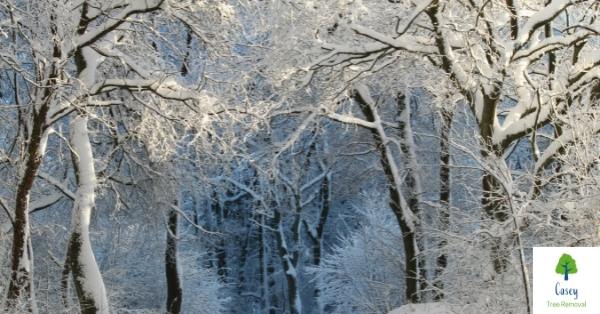Picture yourself sitting inside while a winter storm is beginning to brew. You see your favorite birch tree swaying back and forth, taking the brute of the storm with ease. Your immediate thought is, how can my birch adapt to the winter cold and force of each storm that passes? When asking this question, you are not alone. Most people known trees become bare during the winter months, but most do not know how trees keep themselves alive during these months.
The layers of a tree that live below the ground, and sometimes even two feet of the trunk is covered and protected with a healthy layer of snow. The exposed part of a tree during winter experiences the brute of every storm.
Preparation for How Trees Survive Winter
Trees prepare for winter during late summer, early fall. As the length of the days shorten, and the cold temperatures begin once the sun falls, trees leaves, stems, and roots experience several physiological changes. Trees losing their leaves is the first part of dormancy, and acceptance of winter. Winter affects trees by them not making food, which is why losing their leaves is a way to maintain their energy. When trees lose their leaves, ABA (Abscisic acid) a chemical is produced in buds. These buds release the leaf they are connecting to the tree once an amount of ABA gathers in that bud.
Trees lose their leaves to maintain energy which is formed through their food intake. Trees have metabolisms, much like us, that fluctuate more frequently than our own. Trees metabolism slows down during dormancy which impedes cell growth. With this slow metabolism, trees can use up their food slowly and only for functions essential to maintaining its longevity.
The Ways Trees Combat Freezing
- The first way is for trees to change their membrane to become more pliable resulting in water migration out of cells and into the space separating those cells. The water taking up this space presses against the cell walls but is offset as cells in colder temperatures decrease in size and take up far less space. As most know water expands when it reaches its freezing point, hence why the cells choose to extract their water, so they do not burst during the cold of winter. Tree freeze does not occur while using this first way to combat winters brute.
- The second way a tree combats the winter cold is through a sweating process. In autumn a tree begins converting starch to sugars, in Melbourne, we are more than familiar with this process considering our large selection of sugar maples. Sugar acts as a sort of antifreeze against the cold weather. The fluid residing in the living cells concentrates on the sugars causing a lower freezing point within the cell itself. This makes the fluid floating between the living cells to freeze only squeezing and not bursting the living cells due to their increased pliable nature in winter.
- The last way in which trees can combat the winter cold results in the liquid cell becoming viscous so they are solid. This type of solid nature mimics that of silica in the supercooled glass. This type of combat can only take place if the first two ways occur allowing for the supercooled contents of the living cells to avoid completely crystallization.
Trees are remarkable plants that spend their whole lives combatting external factors that are trying to threaten their lives. Winter and trees go through a series of phases to stay alive.
Casey Tree Removal – All Tree Services including Tree Cutting, Tree mulching, Tree Trimming, Stump Grinding, Tree Pruning, Stump Removal, Emergency Tree Removal Experts In Melbourne!
Click here to read more articles regarding tree removal & related services.
If you are in 15 Stockyard Dr and looking for Casey Tree Removal, below is the best way to visit us.


Recent Comments